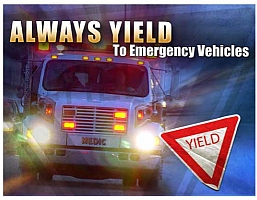When you see sirens & lights, remain calm .
Do keep a foot on the brake to alert the emergency
vehicle driver that your vehicle is stopped or stopping.
Once stopped, remain stopped.
Do be alert when you see a fire
engine or a medic unit coming out of its station, pull to
the right-hand side and stop. The law requires you to pull to the right-hand side and yield to an emergency vehicle, even before it gets on the road.
Do pull
parallel to
the right-hand edge or curb and stop.
Once stopped, remain stopped.
Do remain stopped until all emergency vehicles have
passed.
Do pull over into the right-hand lane as the traffic in the
lane to your right-hand side moves over.
Do move over or slow down when approaching
stationary emergency vehicles with lights activated.
Do
provide a three feet clearance when passing a
bicyclist. (New Ohio State law effective 3-22-2017)
Do
remember that funeral processions are classified as
emergency vehicles. Drivers are required to yield to funeral
escort vehicles displaying proper audio or visual signals.
![]()
Do not
stop in, just before or just after a blind
curve if that action paralyzes forward movement of the
emergency vehicle. Keep moving until there is a path for the
emergency vehicle to pass.
Do not
stop on the uphill side, the downhill side or while
cresting a steep hill on a two-lane road if that action
completely paralyzes forward movement for the emergency
vehicle. Keep moving until there is a path for the emergency
vehicle to pass.
Do not
stop in an
intersection.
Do not
follow within
500 feet after the emergency vehicle's have passed.
Do not
assume there is
only one emergency vehicle.
Do not
race ahead to get
through a green light or turn before the emergency vehicle
gets there.
Do not
turn quickly to the
left into a driveway or street.
Do not
drive through a red light or stop sign when an
emergency vehicle approaches.
Do not
panic and slam on the brakes.
Also Note
-
Just because an ambulance is not running sirens and lights does not mean they do not have a patient on board. Ambulances transport patients, assume a patient is on board even without sirens & lights. Please do not cut in front of them. If you were an ambulance patient consider how you would respond if the vehicle driver had to suddenly slam on the brakes because of being cut-off.
-
If you are walking, you also have responsibilities. Get off the road way as much as possible. If you are about to cross, stay where you are. It is difficult for most motorists to see you in normal circumstances. When an emergency vehicle is approaching the driver may be focused on finding the emergency and may not scan to see you.
-
If there is one emergency vehicle, there may be more. Don't assume it is safe to enter an intersection just because emergency services has come through. Be alert and scan for the approach of other vehicles.
Watch
How to Reduce 9-1-1 Delays!
Documents to Reduce 9-1-1 Delays
The information,
documents and downloads on this website are open source and free to download
and use for your organization. Under no circumstance are they to be sold or
used to make a profit. All Rights Reserved - Lee Hite
Reduce 9-1-1
Delays (Checklist)
Items for
the 9-1-1 Premise Page
Emergency Medical Data
Sheet English
9-1-1 Addressing That Works
Emergency Medical Data
Sheet Spanish
Emergency Shut-Off Signage
Emergency Medical Data
(Long Form English)
Healthy Hydrants Guideline
Emergency Medical Data
(Example)
It's Okay to ASK
Alternate Key Holder
Registration
Sirens & Lights Guidelines
Alternate Key Holder
Information
Family Records Retention
Forms
Become a Helpful Responder – Not a Helpless
Bystander


